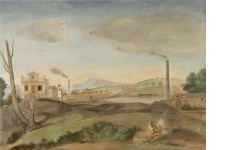Ελαιογραφία 354Σχέδιο 113Τέμπερα 26Υδατογραφία 330Παστέλ 139Νωπογραφία 6Αυγοτέμπερα 9Μικτή Τεχνική 129Χαρακτική 61Ακρυλικά 36Ψαρόκολλα 3Gouache 33Γλυπτική 1Λαδοτέμπερα 1Καζεΐνη 1
Ειδικές Πληροφορίες για τον Καλλιτέχνη
TITΛΟΣ ΕΡΓΟΥΤο σπίτι του καλλιτέχνη / Μουσείο στο Μαρούσι με έναν άγγελο
ΔΙΑΣΤΑΣΕΙΣ ΕΡΓΟΥΎψος : 73
Πλάτος : 100
ΥΛΙΚΟ ΚΑΤΑΣΚΕΥΗΣΕλαιογραφία (Λάδι σε καμβά επικολλημένο σε χαρτόνι)
ΥΠΟΓΡΑΦΗ ΚΑΛΛΙΤΕΧΝΗΚάτω Δεξιά
ΧΡΟΝΟΛΟΓΗΣΗ01-01-1972
ΕΛΕΓΧΟΣ ΓΝΗΣΙΟΤΗΤΑΣΔεν έχει ελεγχθεί

Provenance
Private collection, Athens.
Literature
The Greek Painters, vol. 2, The 20th Century, Melissa editions, Athens 1974, p. 321 (illustrated).
Serenely luminous, discreetly noble and irresistibly attractive, this visual treatise on pure form and truthful vision by an emblematic figure of Modern Greek art is drawn by the poetry and tranquillity of the Attic landscape to suggest balance between the natural and the manmade.
Radically simplified in design and brilliantly translucent in colour, the composition is captured in the warm light of a summer's day, following the classic horizontal layering used in depicting sequences of topographic formations in panoramic landscapes, while the buildings on the middleground seem to peacefully float on the wavy terrain of the Athens suburb of Maroussi, perfectly integrated into the age-old surrounding space. As Tsarouchis himself once noted, "elementary logic and simple aesthetics compels us when building on a hilly landscape to not commit the hubris of erecting enormous structures and compete with nature's greatness."1 The view, which extends far across the countryside to the distant Mt. Penteli, is animated by the discreet presence of a seated angel with libellule (dragonfly) wings2 who conveys a mood of pensive serenity and grace, echoing the artist's 1936-1938 Thinker series (compare The art critic in blue jacket, Bonhams Greek Sale 23.5.2006, lot 111). The meditative, lyrical tone of the austere and timeless landscape is heightened by the billowing pillars of faint smoke rising from the two kiln chimneys, which together with the barren tree trunk on the left masterfully frame the composition, and by the grey silhouettes of two freight wagons that recall Giorgio de Chirico's evocative images of distant trains.
Resting on a gently sloping elevation and evoking an atmosphere of discreet elegance, the neoclassical mansion on the left is an imaginative portrait of the home/studio Tsarouchis built in Maroussi in the 1960s. In 1962, upon his return to Athens from Paris, the artist decided to purchase a plot of land and looked in the areas of Pefki and Maroussi. Finally his friend, the multi-faceted Thanos Veloudios found a suitable property in a sparsely inhabited part of Maroussi consisting mostly of open fields and pine tree groves. As noted by the painter F. Tarlow, "on a palm tree lined street with no other house around."3 The then Director of the Athens National Gallery M. Kalligas supported the artist's venture by commissioning a large painting and paying for it in advance. This piece of land was very important to Tsarouchis, who visited it often, daydreaming for hours and picturing in his mind's eye the shape of the house he was going to build there. As soon as construction reached its final phase, the artist was sued by a local gendarme for exceeding the height limit, the cause of contention being a pedimental structure on the flat roof. The suit was tried and the artist was acquitted after convincing the judges that what he had done was by no means self serving but, rather, driven by purely aesthetic considerations in pursuit of true beauty. He eloquently explained that the pedimental structure echoed the triangular shape of neighbouring Mt. Penteli [a relationship that is clearly evident in the Bonhams picture] and as a further justification he elaborated on the harmonic proportions of the Parthenon pediments."4 The artist's house at 28 Ploutarchou Street in Maroussi, so lovingly portrayed in the painting offered at auction, is actually an inspiring stage set much like the ones he designed for the theatre, a work of art in itself.
1. Preface to the second edition of S.B. Skopelitis, Neoclassical Buildings of Athens and Piraeus [in Greek], Gnosi editions, 1981.
2. Images of libellules are common in Art Nouveau, especially in jewellery designs.
3. F. Tarlow, "Memories from my Years with Tsarouchis" [in Greek], Ωσει Μύρα, Yannis Tsarouchis 1910-1989, Kastaniotis editions, Athens 1998, p. 501.
4. See Ioannis Tsarouchis by Alexios Savakis [in Greek], Kastaniotis editions, Athens 1993, pp. 152-154.